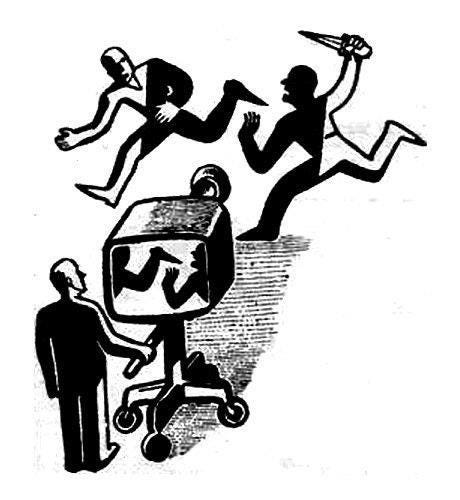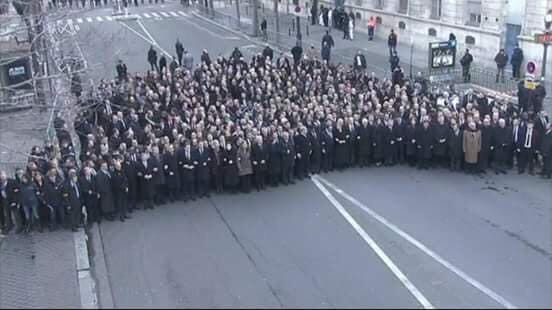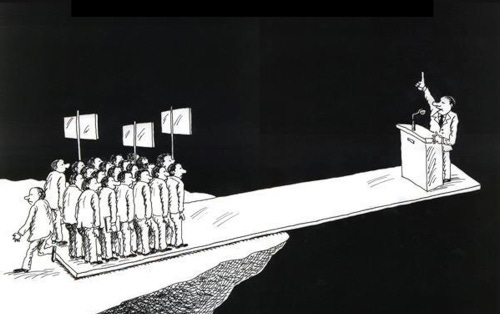Context Is Everything
by James Corbett
corbettreport.com
October 22, 2023
I often get asked about an image I've had cause to include in several of my articles over the years. It depicts a television camera capturing a knife attack in such a way as to completely flip the reality of who is attacking and who is being attacked.
In case you haven't seen it before, here it is:
I would happily credit whoever created this image, but I can't. It's been floating around on the internet for decades now, and I've never once seen it credited to a particular artist. It has, however, been posted and re-posted so much that it's generated its own lore at this point.
Some say that the cameraman framed both of them.
Others insist there's a gun pointed at the cameraman's head, just outside the frame of the picture.
Whatever the case, it's easy to see why the image has generated so much interest over the decades (and continues to do so, judging from the feedback in my inbox). It's because it perfectly encapsulates a point that I will now spend thousands of words elaborating: context is everything.
If you have already internalized this point and you understand how this insight has been weaponized by the powers that shouldn't be, great! But here's another point to consider: we can use this insight about the importance of context to our advantage.
How? Allow me to explain. . . .
FRAME WARS
Do you remember when I demonstrated how people's perceptions of an entire nation can be fundamentally altered by simply pointing a camera in a different direction?
Well, the bigger point, for those who missed it, is that corporate presstitutes use this technique all the time to manipulate our perceptions of important issues.
Remember when the BBC showed what it purported to be a crowd protesting against then-Iranian president Mahmoud Ahmadinejad:
. . . which was actually a cropped picture of a pro-Ahmadinejad rally?
Or when CityNews and other elements of the lying lapdog media in Canada tried to convince you that this was a representative image of the Freedom Convoy:
Instead of, you know, this:
Or when the world press tried to convince us that the brave Leaders of the Free World courageously linked arms to demonstrate their commitment to free speech by leading the Paris unity march in the wake of Charlie Hebdo?
Only for random Twitter users to point out how the whole thing was a complete charade that took place on an empty, guarded street?
And who could forget when the lying cameras of the bought-and-paid for establishment press pulled in nice and tight on a Hillary Clinton rally during the 2016 presidential (s)election . . .
. . . so that they could hide the fact that Queen "Why aren't I 50 points ahead?" Hillary couldn't even fill out a high school gymnasium with supporters?
And it's not just literal photographs that are manipulated to provide misleading contexts, either.
Think about the lies, damned lies and bar charts of the statisticians, who want you to be DEATHLY AFRAID of their (lying, manipulative, phoney, doctored and conveniently color-coded!) global average temperature charts showing the last 140 years of (mostly fake) global warming data:
. . . but definitely DON'T want you to put that data in its historical perspective:
And of course the manipulation of context is not confined to the visual realm. Headlines, quotations and sources can be fiddled with to transform the reader's understanding of a story.
Remember when those evil Covington High School students, led by arch-white supremacist Nick Sandmann, physically threatened and cruelly mocked an innocent Native American protester at the National Mall in Washington, D.C.?
And then do you remember when the mainstream pundits and anchors who had mused about punching Sandmann in the face or opined that the Covington kids "might as well have spit on the cross" had to eat crow after video emerged showing that the entire incident was 180 degrees completely opposite to what was originally reported by CNN, The Washington Post, NBC Universal and the other lying liars of the lamestream media?
OK, I trust you get the point by now: context is everything.
Excluding key context from a news story is one of the simplest and most effective ways that lackey reporters use to mislead the public. In fact, I'd say that it is probably the key method that the establishment media uses to misinform their audience. Yes, sometimes the mockingbird repeaters of the MSM simply lie about matters of fact, but more often these presstitutes do not write factual lies; they lie by omission.
I'm sure you can think of a million more examples of this phenomenon. Feel free to go ahead and leave those examples in the comments section of this newsletter at corbettreport.com. But, as cathartic as it might be to do that, perhaps there is something more important to be taken out of this "context is everything" insight.
Beyond simply identifying the technique of context manipulation, can we use our understanding of this technique to formulate a solution to the problems that we face?
As it turns out, we can use this seemingly simple insight—namely, that we can gain a different perspective on a subject by simply recontextualizing it—to our advantage.
REFRAMING THE PROBLEM
There's another image I often cite that I believe lives up to the old "a picture is worth a thousand words" adage. It's the one that shows a politician on the far end of a plank dangling over a cliff. He's being literally propped up by the folks listening to his speech on the other end of that plank. But one person—presumably disillusioned with the politician—is stepping off the plank.
It's another one of those cartoons that, like the TV knife attacker cartoon, is of indeterminate age and origin but feels like it has been around forever because it conveys a profound truth in one simple, instantly understandable image.
In this case, the truth being conveyed is one that no amount of "people power" sloganeering can ever get across to people in quite the same way. Yes, we are literally supporting the political puppet show (and the politicians in it) with our participation. Ending that show is as simple as walking away.
More generally understood, this is a point I have been at pains to stress in my work on solutions for years now. The real failing of the conspiracy theorists is that they tend to picture humanity as the helpless captives of a They/Them/Those composed of all-powerful Davos Illuminati Jewish Vatican Space Laser elitists whose terrifying strength and awesome resources make them completely unassailable and ensure that their plans inevitably and unerringly come to fruition.
This narrative of the God-like, untouchable elite is inherently demotivating. "What's the point of even trying to resist? The powers-that-shouldn't-be will get their way in the end anyway." In this sense, this narrative is functionally indistinguishable from enemy propaganda. By discouraging people who would otherwise stand up to them, the conspirators have probably done more to retain their dominance than by employing any other method of control.
So, what if we reframe the picture? Can we recontextualize the problem of our enslavement to a global technocratic conspiracy in such a way as to free ourselves from this inherently demoralizing narrative?
What if, instead of seeing ourselves as the helpless victims of the omnipotent Gateses and Schwabs and Rothschilds of the world, we see them in the same position as the politician on the plank hanging over the cliff? What if, instead of seeing these pathetic psychopaths as World-Bestriding Colossuses who gained their wealth and power through superior intellect and cunning, we instead realize that their apparent authority over us comes directly from our participation in their system?
In other words, what if we acknowledge that we are the ones propping up their system of control—and all we have to do is step off the plank?
By reframing the scenario in this way, we not only rob the men behind the curtain of their air of invincibility and thereby motivate ourselves and others to take action in the real world, but we also begin to understand exactly which of our actions will actually be effective. If we are in fact the ones who are ultimately enabling this system of corporate/governmental/financial control with our own participation—using their money, shopping at their stores, buying their products, eating their food, voting in their rigged (s)elections, watching their news, etc.—then it follows that we can topple that system by removing ourselves from that system.
Now, there is obviously more involved in fighting a millennia-long conspiracy to suppress free humanity than simply bowing out of the system, as I have no doubt my well-educated audience will rightly observe. But by reframing the problem, we're at least shaking off the apathy generated by the All-Powerful Illuminati conspiracy narrative and can begin taking action to bring about the world we want to live in.
Or, as I sometimes put it: we need to stop begging for scraps from the master's table and create a table of our own.
OK, so here's my idea: I think this concept might be expressed in visual form with a depiction of Atlas, the Titan of Greek mythology who is condemned to hold up the sky for all eternity. We all know the traditional representation of Atlas, struggling to hold up the earth on his shoulders, and we know how writers like Ayn Rand have made use of this mythology for their own purposes. So, how about an image showing Atlas bearing a different burden—not the globe, but the Illuminati pyramid with the All-Seeing Eye as its capstone? And what if Atlas decided to "shrug off" that burden? Wouldn't the pyramid fall to the ground and shatter?
Is this a stupid idea for a political cartoon? Probably. I'm not a visual artist and I don't claim to be one. So consider this a challenge for the visual artists in the crowd: how would you express this concept in a single, timeless, immediately comprehensible image like the ones we looked at above?
And here's a challenge for the rest of you: how would you reframe the problem of the globalist technocratic conspiracy in a way that inspires people to take action and make changes in the world? Can you come up with an angle or a different narrative context that explains not just the problem but the solution in a simpler, more straightforward way than I've attempted here?
I look forward to seeing what you all come up with.
Thanks for reading. Would you like to comment on this article? Would you like to access the full Corbett Report Subscriber newsletter, including recommended reading and viewing and a discount for purchases at the New World Next Week store? Would you like to support me in creating more of this type of content? Then please consider becoming a Corbett Report member today.
















